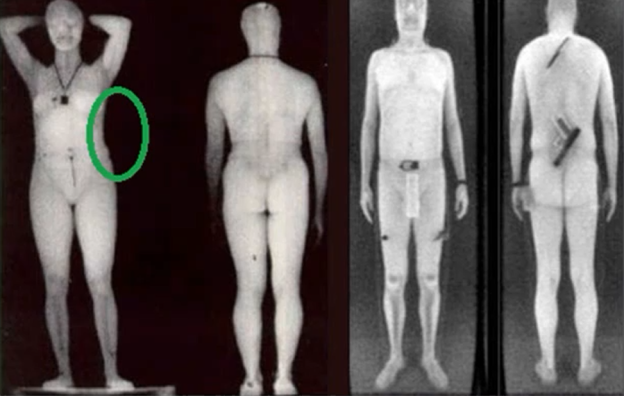
Jonathan Corbett, who has been embroiled in a civil suit against the TSA since November 2010 and taking the case to the Supreme Court, turned to the Internet to reveal just how easily the TSA’s nude body scanner can be easily undermined. In watching his YouTube video, we’re compelled to wonder about the efficacy of such scanners in catching the next shoe bomber. Are the scanners in fact just a $1 billion dud?
In its efforts to maintain the security for passengers in the case of another bomb threat, the TSA has conjured up all sorts of contraptions and preventative measures that have succeeded to varying degrees. In the last two years, after the failure of the “puffer,” a machine intended to capture bomb reside from a puff of air, the government pursued the next available tech. According to the TSA, it purchased 600 nude body scanners at nearly $200,000 per machine, which have been deployed in 140 airports nationally. What they did not expect was the outcry and public backlash.
The public’s concern has been directed at the sheer invasion of personal privacy by a machine intended to reveal the nude body to a screening TSA agent. In turn, policy makers and governing bodies have had to weigh the risk of a successful, albeit rare, terrorist attack, against the privacy of passengers.
The scanner to a degree serves as a psychological deterrent for passengers intending ill-will on others. In other cases, with the help of scanners, the TSA has uncovered guns, knives, grenades and even a loaded spear gun. But passengers attempting to carry on prohibited items had not been privileged with the information that bypassing the screening merely required a swatch of fabric and a sewing kit.
The TSA screens only the front and back of your body within the scanner, and the detection of a prohibited carry-on item is achieved visually by an agent. When scanned, a passenger’s body is revealed on-screen as a white figure juxtaposed to a black background, and a concealed object is noticeably rendered black. Due to this technicality, any object shown against a black background will be rendered undistinguishable to the human eye. As Jonathan demonstrates in his video, simply sewing a pocket to conceal the item on the side of any shirt will suffice for any passenger attempting to bypass the scanners undeterred.
Digital Trends talked to Jonathan about his video and asked him why there was such a proactive backing from the government to integrate these scanners, to which he clued us in to four scenarios:
I think there could be many reasons, some well-intended, some not:
1) Because someone may actually foolishly believe they make us safer
2) Because the body scanner manufacturers have government connections and lobbyists
3) Because the government wants to condition Americans to accepting more invasive searches and airports are a good place to start because people are afraid
4) Because the TSA likes shiny, expensive new toys (seriously).
We reached out to the TSA regarding the video and TSA spokesperson, Lisa Farbestein, informed Digital Trends that the video was, “a crude attempt to allegedly show how to circumvent TSA screening procedures.” She declined to go into detail about the technology but the confidence in the machines was evident. “TSA conducts extensive testing of all screening technologies in the laboratory and at airports prior to rolling them out the field,” Farbestein said. “Imaging technology has caught many items large and small, and is one of the most effective tools available to detect metallic and non-metallic items, such as the greatest threat to aviation, explosives.”
If in fact the TSA has been mistaken about the efficacy of the X-ray scanners, it’s a daunting uphill battle for Jonathan as he reveals that its use in screening passengers traveling by train, subway and bus is catching steam. The Australian government only days ago announced a $28 million overhaul of their security system to integrate the scanners throughout the country, and would require passengers to be scanned or risk losing their ride. But, to the credit of the latest designs, the Australian scanners is purported to depict passengers as “stick figures,” which will render the people in them unidentifiable.

According to Farbestein, the upgraded scanning software in question, intended to protect passenger’s privacy, are currently being testing in the United States for its more advanced, “backscatter” body scanning devices. Its earlier model, “millimeter wave” scanners, have been updated with the latest software. “The TSA recently installed new software on all millimeter wave units currently in use – upgrades designed to enhance passenger privacy by eliminating passenger-specific images and instead auto-detecting potential threats,” Farbestein said. The new upgrade is coined, “automated target recognition” as the software is able to highlight the general location of the perpetrating object. “TSA plans to test similar software on backscatter technology in the coming months,” Farbestein added.
In the event that Jonathan’s efforts prove to be successful, we asked of him suggestions for maintaining the security of passengers, while outwitting the rare outliers intending harm.
“My understanding is that the number one fear of “the terrorists” is bomb-sniffing dogs. These cute and non-invasive little things can do better than anything we can create and cost a fraction of a nude body scanner,” Corbett informed us. “Re-enforcing cockpit doors, arming pilots, and a watchful set of passengers has done much more to prevent another 9/11 than the TSA has.”
Edit: Included comments from TSA spokesperson, Lisa Farbestein. Image of upgraded scanner software provided by TSA included.


